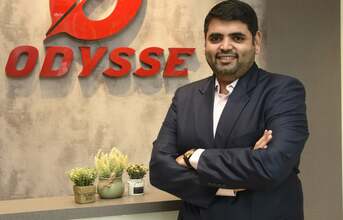
With an electric revolution in place, what sets Odysse apart from prominent EV two-wheeler players such as Ather, Bajaj, etc.?
There are two things that we believe sets us apart in the market. First, compared to other brands we have given extra focus to the battery and charging stations, keeping the Indian climate in mind. We are continuously investing our time and efforts to provide a better and improved battery pack by using thermal sheets and gel which enables us to reduce heat generation and further ensures that the heat is routed out of the box. Second, the battery we use in each Odysse vehicle is passed through more than 50 checkpoints during its manufacturing process and is thoroughly tested by our technicians before installation & dispatch.
With the EV two-wheeler market getting further saturated with new and existing players, how do you plan on further entrenching and making a mark in the industry?
Any new industry is bound to encounter a phase where the market will get overcrowded but eventually, it gets consolidated too during its lifespan. We are constantly thriving to make our products safer and more advanced to ensure that we are exceeding the market offering and also developing new products where there is a void which can be filled by us, as a result, attracting new customers and retaining a base of loyal customers.
Although the market is growing with new players, customers are still reluctant to opt for an EV two-wheeler over a petrol-based bike. New policies have been bought in, and charging infrastructure is improving, so where do you think we are still falling short?
There have been a lot of efforts made in the EV segment though the recent safety issues have tightened the norms and brought a slight slump in the sale. Limited charging stations and their low viability are other significant barriers to the government's efforts to promote green transportation. There are only a few thousand chargers across India, some of which are in functioning order and others are vulnerable to the whims of local utilities over the power supply. This also is getting in the way of increasing EV sales, which recently struck a roadblock following a string of electric vehicles catching fire.
EVs are supposedly a sustainable alternative to ICE vehicles, on-road, however, EVs sustainability only plays out when it comes to emissions. The mining to manufacturing and charging processes for EVs is not sustainable, and not much headway has been made on the front. How can EVs be made more sustainable and circular?
For a mineral or even fossil fuels, there is always going to be mining carried out. But fossil fuel pollutes the air on top of other pollution. Alternatively, there have been efforts going on to invest in a new type of battery and also to reduce the use of expensive and rare minerals usage in existing lithium batteries to ensure even mining pollution is drastically reduced over time which is not possible with fossil fuels.
Your company offers both li-ion and lead acid-based scooters. What difference does it bring in the end product and the riding experience?
Lithium-ion and lead-acid batteries are the two most popular varieties. Different performances, life cycles and prices emerge from these chemical variations. For large-scale stationary applications with plenty of available space and minimal energy needs, lead-acid batteries work well. As a result, they are mostly utilised in power plants and inverter-type systems for storing renewable energy. However, lithium-ion batteries offer the same power in a much smaller volume thanks to their significantly higher energy density. These batteries are environment friendly and do not cause severe health hazards. Lead, on the other hand, is a toxic substance that harms the environment and living beings in a comparable higher manner.
In addition, li-ion batteries do require less energy for maintained charging. Lead-acid batteries have a charge cycle efficiency of 80-85 per cent whereas lithium-ion batteries are 90 per cent efficient. Except for rapid charging technology, which drastically reduces the time, one lithium-ion battery pack charges to 100 per cent in around 2-3 hours whereas the Lead-acid takes time of about six to seven hours to fully charge
Lead acid usually has a 300-400 charging cycle capacity whereas lithium batteries can go up to 2500 charging cycles. On the other hand, the lead acid battery costs 50 per cent of that of lithium batteries but li-ion batteries are long-lasting and have a much lower cost of ownership over the life of the EV.
With experience gaining prominence in EVs, how are you working on creating a connected ecosystem for your two-wheelers?
We have recently developed our IoT system wherein customers will have an enriching user experience by making them aware of the money & CO2 saved by driving an EV compared to an ICE vehicle. IoT can also gauge the absolute & relative parameters such as speed, acceleration and braking pattern for providing tips to ensure better vehicle performance and reduce maintenance. Theft can also be prevented through realtime tracking, geo-fencing and immobilisation that enhance security and reduce the safety-related risk.
What are the short-term and long-term plans for Odysse?
We recently launched our product V2 & also developed our IoT. We have two other launches planned this year which would be a variation in electric bike and a cargo scooter catering to last-mile delivery service providers. We have 60+ dealerships across India and plan to cross 100+ dealerships by March 2023 and 200+ dealerships by 2024. Our R&D team is constantly working on upgradation of our existing models in addition to developing new products for the coming years.


























